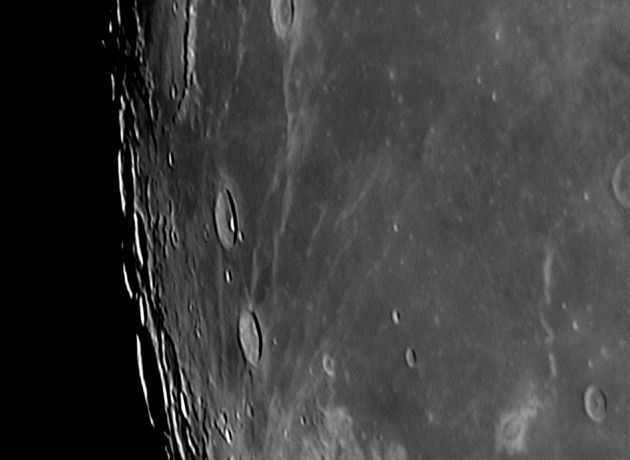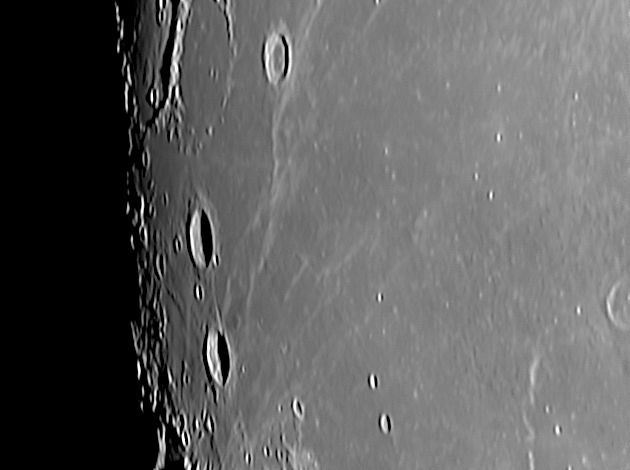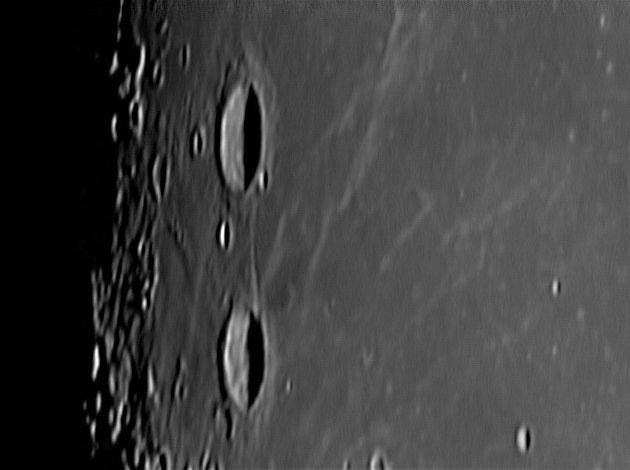

Move your mouse over the picture to see the names of the various features.
 There are a number of well-known names on this picture even if Galilaei (named after that giant of 17th century astronomy Galileo Galilei) seems a little oddly spelt. There were three eminent astronomers called Struve (father, son, and grandson); the VMA says it is named after the father, who died in 1864, but Charles Wood, in his excellent book The Modern Moon, refers to "Three giants of 20th-century astronomy" implying the grandson (1897-1963). I took the picture in an attempt to resolve the cleft linking Krafft to Cardanus, which I have but only just. The cleft, known as Catena Krafft,
is a chain of craters which is not radial to either Cardanus or Krafft and yet it seems it must have been formed by ejecta from one of them. (Actually it would have to be Cardanus because high-resolution pictures from Lunar Orbiter show that the chain continues onto the floor of Krafft.) The two craters are twins being of the same age (about 3,500 million years) and the same size (53 and 51 Km respectively), but Krafft
is quite dark and would be quite difficult to find under high lighting if it was not for Krafft C which is bright, whereas Cardanus is much brighter under these conditions. The bright streak across the mare from Cardanus to Seleucus is the southern part of an interesting ray. The origin of this part is thought not to be Cardanus but Olbers A, which is below the southern edge of my picture. The ray continues north
of Seleucus but changes direction and the source of this section is uncertain.
There are a number of well-known names on this picture even if Galilaei (named after that giant of 17th century astronomy Galileo Galilei) seems a little oddly spelt. There were three eminent astronomers called Struve (father, son, and grandson); the VMA says it is named after the father, who died in 1864, but Charles Wood, in his excellent book The Modern Moon, refers to "Three giants of 20th-century astronomy" implying the grandson (1897-1963). I took the picture in an attempt to resolve the cleft linking Krafft to Cardanus, which I have but only just. The cleft, known as Catena Krafft,
is a chain of craters which is not radial to either Cardanus or Krafft and yet it seems it must have been formed by ejecta from one of them. (Actually it would have to be Cardanus because high-resolution pictures from Lunar Orbiter show that the chain continues onto the floor of Krafft.) The two craters are twins being of the same age (about 3,500 million years) and the same size (53 and 51 Km respectively), but Krafft
is quite dark and would be quite difficult to find under high lighting if it was not for Krafft C which is bright, whereas Cardanus is much brighter under these conditions. The bright streak across the mare from Cardanus to Seleucus is the southern part of an interesting ray. The origin of this part is thought not to be Cardanus but Olbers A, which is below the southern edge of my picture. The ray continues north
of Seleucus but changes direction and the source of this section is uncertain.
Reiner γ is another interesting feature in the picture. Dr Wood, in his book, describes it as the only example on the visible side of the Moon of a feature called a swirl. Orbiter pictures show it to be a hill (or maybe better described as a plateau) and composed of lighter material than the surrounding mare. There
appears to be no agreed explanation for this feature, but it is the centre of a strong magnetic anomaly, a magcom, (so maybe Arthur C. Clarke put T.M.A.-1 in the wrong place...).
The scale markers are 100 Km north and east and apply to the area of Krafft.
The picture was taken with a ToUcam attached to my LX200 on 25th March 2005 at 00:13 UT when the Moon was 13.9 days old.
Date and Time: 25 March 2005 00:13 UT
Camera: ToUcam 740K
Telescope: LX200 at prime focus (FL 2500 mm)
Capture: K3CCDTools. High gamma, 1/50", 0% gain, 151 frames
Processing: Registax. 284 frames stacked. Wavelets 1,2 = 10, 3 = 5, Histogram 48-128

I took this picture specifically to try to capture a better image of Catena Krafft. This is a narrow feature, only about 3 Km across, and it is not well resolved, but it is there.
The scale markers are approximaely 100 Km north and east and apply around Cardenas.
The picture was taken on 11th May 2006 when the Moon was 13.4 days old.
Date and Time: 11 May 2005 21:53 UT
Camera: ToUcam 740K
Telescope: LX200 at prime focus (FL 2500 mm)
Capture: K3CCDTools. High gamma
Processing: Registax. 155 frames stacked. Wavelets 1 = 10, 2 = 5, gamma 1.4

And finally a closer view imaged through my X2 adaptor lens. I don't think the resolution is any better.
The scale markers are approximaely 100 Km north and east and apply around Cardenas.
The picture was taken on 11th May 2006 when the Moon was 13.4 days old.
Date and Time: 11 May 2005 22:17 UT
Camera: ToUcam 740K
Telescope: LX200 with X2 adaptor lens
Capture: K3CCDTools. High gamma,
Processing: Registax. 106 frames stacked. Wavelets 1 = 20, 2-3 = 10
Home Back to NW Quadrant